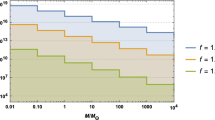Abstract
In the Affleck–Dine–Linde scenario of baryosynthesis, there exists a possibility of creation of sufficiently large regions with antibaryon excess, which can evolve in antimatter globular clusters only in the result of domain evolution and only at the stage of galaxy formation; their number is demonstrated to increase as a function of time, being determined by the mechanism of antibaryon excess generation and on the properties of the inflaton field and related ones, the Hubble-parameter function at the inflationary stage, as well as the field initial conditions in the Einstein field Equations. Possible discovery of antimatter globular clusters would specify the mechanisms of inflation, baryosynthesis and evolution of antibaryon domains in a baryon-asymmetrical Universe.
Similar content being viewed by others
Notes
The characteristical features of the antimatter domains are defined both in the gravity background and within the antibaryon-nucleosynthesis mechanisms. The minimal mass for an antimatter domain to evolve in time without being annihilated is estimated as \( \simeq {\kern 1pt} {{10}^{3}}{{M}_{ \odot }}\) for a temperature below 4000 K, with the initial condition of the time \({{t}_{0}}\) corresponding to a temperature of 9000 K; the antimatter density in the antimatter domains is defined as \(3\) orders of magnitude less than the baryon density. For these features, correlation functions can be written after solving the fluid equation for the diffusion coefficient \(D(t)\) via the baryon-to-photon ratio \(r \equiv {{n}_{b}}{\text{/}}{{n}_{{\tilde {\gamma }}}}\), i.e., \(\tfrac{{\partial t}}{{\partial t}} = D(t)\tfrac{{{{\partial }^{2}}t}}{{\partial {{x}^{2}}}}\), \(r({\mathbf{R}},{{t}_{0}}) = {{r}_{0}}\), \(x < 0\), \(r({\mathbf{R}},{{t}_{0}}) = 0\), \(x > 0\), to evaluate the physical distance covered by atoms after the recombination age until the present time.
More fitting expressions can be calculated, according as a function of, and according to, the choice of the statistical estimators most competent with the experimental verification aimed at. Two-point correlation functions, through the use of estimators (Hamilton estimator, Davis-and-Peebles estimator, Landy–Szalay estimator, …), ought to be compared with the evaluation of binomial distributions of pairs of correlated objects; the distances between pairs of antimatter domains can be therefore be estimated after the evaluation of the correlation function \(N(r)\).
REFERENCES
F. W. Stecker and J. L. Puget, Astrophys. J. 178, 57 (1972).
G. Steigman, Ann. Rev. Astron. Astrophys. 14, 339 (1976).
A. D. Dolgov, Nucl. Phys. B 113, 40 (2002); astro-ph/0207441.
A. G. Cohen, A. de Rújula, and S. L. Glashow, Astrophys. J. 495, 539 (1998); astro-ph/9707087.
W. H. Kinney, E. W. Kolb, and M. S. Turner, Phys. Rev. Lett. 79, 2620 (1997); astro-ph/9704070.
M. Y. Khlopov, R. V. Konoplich, R. Mignani, S. G. Rubin, and A. S. Sakharov, Astropart. Phys. 12, 367 (2000); astro-ph/9810228.
M. Y. Khlopov, Grav. Cosmol. 4, 69 (1998).
V. M. Chechetkin, M. Y. Khlopov, M. G. Sapozhnikov, and Y. B. Zeldovich, Phys. Lett. B 118, 329 (1982).
V. M. Chechetkin, M. Y. Khlopov, and M. G. Sapozhnikov, Nuovo Cim. Riv. Ser. 5, 1 (1982).
M. Y. Khlopov, S. G. Rubin, and A. S. Sakharov, Phys. Rev. D 62, 083505 (2000), hep-ph/0003285.
S. I. Blinnikov, A. D. Dolgov, and K. A. Postnov, Phys. Rev. D 92, 023516 (2015); arXiv: 1409.5736.
Y. B. Zel’dovich, I. Y. Kobzarev, and L. B. Okun’, Sov. Phys. JETP 40, 1 (1975).
S. Loertscher, V. Muir, and P. G. Taylor, Commun. Stat. - Theory Methods 46, 4579 (2017); https://doi.org/10.1080/03610926.2015.1088033
S. Heinrich, J. Complexity 6, 231 (1990).
J.-P. Dai and J.-Q. Xia, Astrophys. J. 905, 127 (2020); arXiv: 2008.02970.
A. Pontzen and A. Challinor, Class. Quantum Grav. 28, 185007 (2011); arXiv: 1009.3935.
E. J. King and P. Coles, Class. Quantum Grav. 24, 2061 (2007); astro-ph/0612168.
R. Sung and P. Coles, J. Cosmol. Astropart. Phys. 2011, 036 (2011); arXiv: 1004.0957.
R. Sung, J. Short, and P. Coles, Mon. Not. R. Astron. Soc. 412, 492 (2011); arXiv: 1004.1925.
R. Sung and P. Coles, Class. Quantum Grav. 26, 172001 (2009); arXiv: 0905.2307.
A. Maselli, A. Sabatucci, and O. Benhar, arXiv: 2010.03581 (2020).
N. Beisert, A. A. Tseytlin, and K. Zarembo, Nucl. Phys. B 715, 190 (2005); hep-th/0502173.
Y. Miao, E. Ilievski, and O. Gamayun, arXiv: 2010.07232 (2020).
A. Monnai, Phys. Rev. C 86, 014908 (2012); arXiv: 1204.4713.
I. N. Mishustin, Nucl. Phys. A 734, 36 (2004); nucl-th/0311044.
V. Poulin, P. Salati, I. Cholis, M. Kamionkowski, and J. Silk, Phys. Rev. D 99, 023016 (2019); arXiv: 1808.08961.
Funding
The research by M.Yu.K. was financially supported by Southern Federal University, 2020 Project VnGr/2020-03-IF.
Author information
Authors and Affiliations
Corresponding author
Additional information
Paper presented at the Fourth Zeldovich meeting, an international conference in honor of Ya.B. Zeldovich held in Minsk, Belarus, on September 7–11, 2020. Published by the recommendation of the special editors: S.Ya. Kilin, R. Ruffini, and G.V. Vereshchagin.
Rights and permissions
About this article
Cite this article
Lecian, O.M., Khlopov, M.Y. Analyses of Specific Aspects of the Evolution of Antimatter Glubular Clusters Domains. Astron. Rep. 65, 967–972 (2021). https://doi.org/10.1134/S106377292110019X
Received:
Revised:
Accepted:
Published:
Issue Date:
DOI: https://doi.org/10.1134/S106377292110019X




